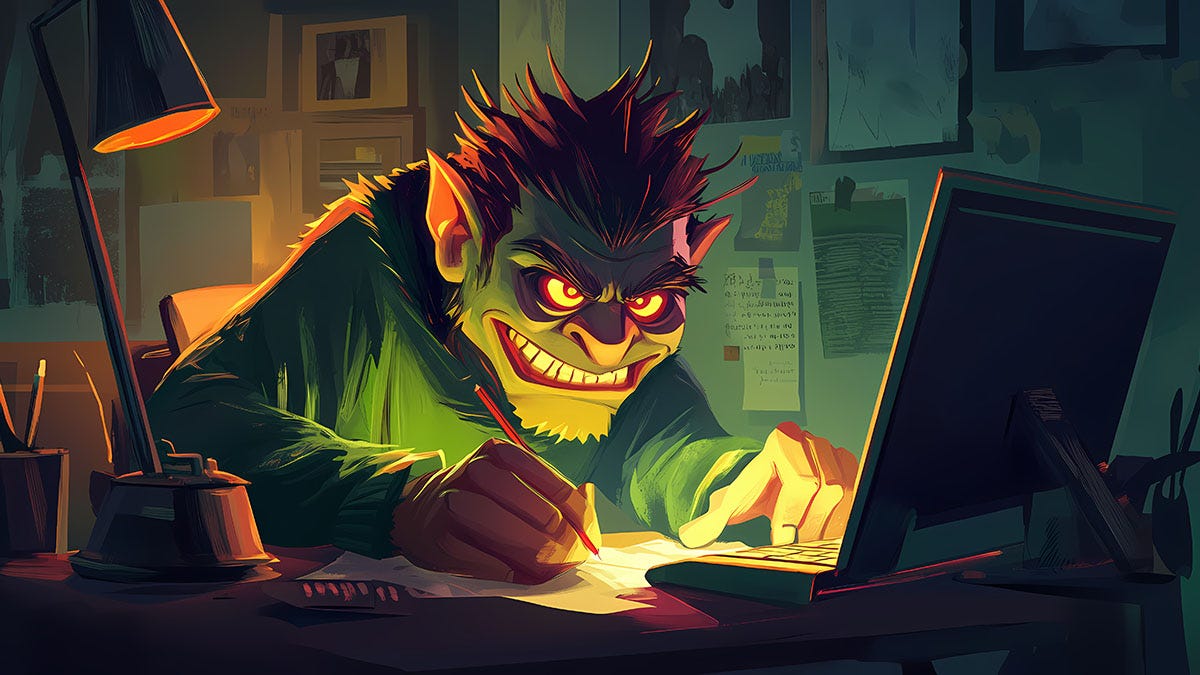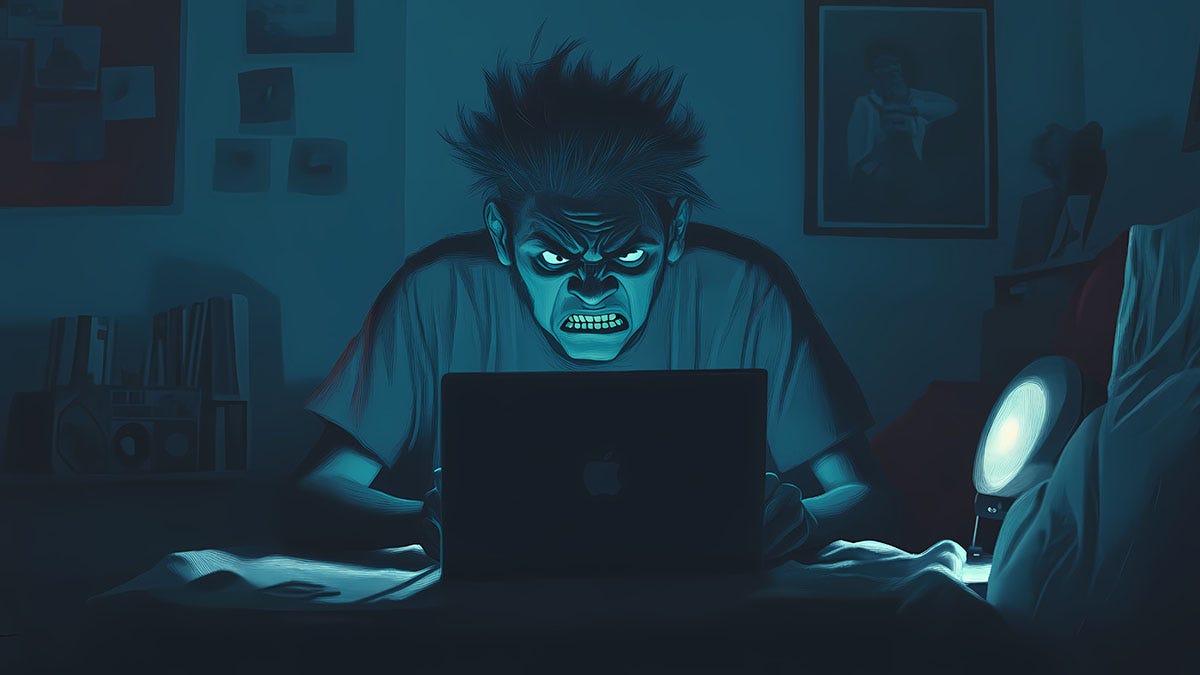engagement through enragement: how and why trolls took over social media
"Are you triggered yet? Because we really, really need you to be..."
I’m a big believer that art needs to be able to push boundaries. Good art should make you think and challenge your ideas of the world around you, and in some cases, yes, it should absolutely provoke you or make you uncomfortable. But the big caveat here is the “should be able to” part. What separates boundary pushing art from just being an engagement-hungry troll is that art has a message to convey with its intended shock factor, while the troll is just trying to get attention to monetize.
The art peels your eyes open and says “look at this and think why it’s happening.” The troll bursts into your feeds to scream “look at me and be shocked and how shocking I am!” The former is intended to start a conversation. The latter is a marketing strategy based on the idea that all press is good press.
Back in those ancient days before social media, the shock jocks, as our elders once called them, tended to be few and far between. They’re like that spicy fried chicken sandwich, the kind that makes your mouth burn and tingle with every bite. Sure, they weren’t necessarily good for you, and they hurt enough to make you rethink your next bite, but they were a much needed and fun adventure every once in a while to break up the boredom and monotony. Almost like a challenge. See if you can finish it before you tap out, or try an even spicier one next time to see how much you can handle.
Today, with the way that social media and legacy news has decided to run things, it’s no longer just an occasional challenge. Every time you open your feed, it’s like being served up that chicken sandwich. Only now it’s coated in Carolina Reaper and ghost pepper hot sauce, and every last bite is pure pain, and no, you’re not allowed to have anything different. Your only choices are how many Scoville units can you go until you go into full blown shock and your airway begins to collapse.
Why? It’s big business. From the scandalous hip-swiveling of Elvis to Kanye arranging a track to yell “Heil Hitler,” there’s been a steady progression of musicians turning the subversive into a new recipe for financial success within the system. Pranks on video platforms went from pretty harmless Punk’d style practical jokes to endangerment or full blown harassment and assaults of innocent bystanders. Social media is full of rage bait by people whose only goal is to get angry engagement. And politicians and cable news pundits are incentivized to be as vile as they dare just to get attention.
It’s a very crowded, loud, and algorithmically mixed up space where every dollar from your content has to be fought over, and engagement is king. Reposting reputable and fact checked news generates a lot less of it than scarring someone for life on video, or openly embracing Nazism, or promising a 1,000+ person orgy, so, obviously, everyone is very incentivized to do the latter rather than the former.
“can you please be triggered now?”
If you thought at some point the big platforms will step in because we’ve clearly gone too far and are still going, the answer is an obvious no. While some creators do get a ban for at least some period of time, behind the scenes, they’re actually loosening the guardrails even further because they’re making billions off ad placement or shares of the shock creators’ subscriptions.
Take YouTube. Rather than trying to enforce its own policies, it’s working on new carve outs for certain videos by declaring that sure, they may break the rules on a sensitive or inflammatory topic, but that may be in the public interest. Meta is doing something very similar, with both claiming that these exceptions are really intended to help news content from getting erroneously flagged.
Meanwhile, YouTube is now allowing medical disinformation and hinting that if you do want to discuss hot button topics like abortion, elections, race, sexuality, or anything else that tends to make people’s blood boil, it’s now open season. More or less. Some restrictions may apply, but they’re not going to tell you what those are because it’s in their interests to be as hands off as possible without risking a PR nightmare. Just stay off their radar and keep bringing them that sweet, sweet traffic and watch time.
Now, on the one hand, I understand why this could be a good thing. If you just ban all discussions about a hot button topic, it doesn’t go away, and a carpet ban just mutes every chance at a nuanced discussion. On the other, given that the incentive structure is to get as many people riled up as you can so they engage, it’s a massive gift to the shock and awe influencers, a green flag to keep pushing their luck and get rewarded for it, crowding out many nuanced takes in the process as more engagement means more money for the platform, hence higher ranking in the feed.
Which brings us back to the structural problem plaguing social media and the battle for our attention. A common refrain is that social media is ruining society because of how it works and what it chooses to prioritize, especially as a majority of us now get our news from it. But I’d argue that it’s not the platforms themselves that are at fault, it’s who owns them today and how they choose to run them.
The early days of social media were not quite idyllic. Plenty of millennials clicked the wrong links and saw some… things. Things we don’t care to talk about ever again. At the same time, we weren’t bombarded with said links with incessant fervor. We saw them as the result of a prank, or morbid curiosity, forwarded to us by another person, often with a warning, or our own bad decisions based on sites we visited.
The first social networks were about making connections and choosing with whom to interact and why. Reach of content was purely organic and rage bait wasn’t effective because engaging with content and actively sharing it were not the same action in the background process that built your feed. You could tell someone off or be disgusted, angered, or merely curious about something without inundating your feed with more of the same engagement bait a minute later.
how and why social media poisoned itself
It all used to be so simple. You connected with certain people, then, when you went back to the website — yes, I know, a site, not an app on your smartphone, which did not exist yet — you saw the latest posts by the people with whom you connected in reverse chronological order. If you wanted to sort them otherwise, it was up to you. If you wanted to explore other spaces, it was up to you. If you really didn’t want to see someone anymore, you could unfollow them. Or just block them if they were a pain.
Then, the owners of social media platforms decided that we needed to spend much, much more time on them for the whole endeavor to be profitable. They wanted to try and recommend you stuff. To take up your time. To steal your attention. Every single moment was another opportunity to scroll by an ad. Now your feed was organized by what would grab your eyeballs most, and if you blocked people, a chorus of bad faith trolls screamed that you were censoring free speech and are a monster for doing so.
Yes, I know what you’re thinking. It sounds like this makes sense, but come on, all the nostalgic millennials who don’t get a midlife crisis because every day since 9/11 — or in my case 12/26/1991 — has been some sort of bizarre crisis, say this. Wasn’t it just businesses reflecting how people used their products?
Well, no. We actually have proof that Facebook purposefully built a machine that can affect your mood, experimented with it, found that outrage and fear get the most user time spent on the platform, and left the machine’s dial on “lies and paranoia” to meet quarterly financial goals. It’s not nostalgia or wistful longing for the days of MySpace and early blogs uglier than sin. We know exactly what happened here and that it was very much on purpose.
It’s also a well documented fact that social media was deliberately made worse, and to continue to make it worse, the platforms increasingly incentivize engagement trolls by rewarding them for virality, good or bad, while also actively ignoring who you are connected to, how, and why, prioritizing engagement through enragement over every other possible consideration for constructing your feed.
Ultimately, this is the dilemma we have today when it comes to social media. We can absolutely fix it. But if we do fix it, it will no longer be nearly as profitable. People will spend less time on it, fewer things will go viral, and the goal will be to use them as a tool to build real life communities instead of continuing to stare at the screen all day. Which is precisely why our AI-worshipping, technobabble-spewing tech broligarch overlords don’t want to fix it.
They need us to be lonely, miserable, angry shells who can’t let go of their phones, yelling at chatbots for hours on end. And if we won’t do that, they’re hoping that we can at least keep on falling for their engagement bait. Maybe something in the Nazi, streaming orgy, car crash, or public violence category…




